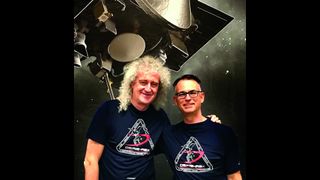Queen legend Brian May helped NASA ace its asteroid-sampling mission, new book reveals
Asteroid Bennu proved a trickster for NASA's OSIRIS-REx asteroid explorer, rewriting everything scientists had thought about space rocks.

Queen guitarist Brian May and Dante Lauretta, the chief scientist of NASA's asteroid-sampling OSIRIS-REx mission, have collaborated on a book about the asteroid Bennu — and it's not a PR stunt.
OSIRIS-REx snagged a sample of Bennu in October 2020 and is currently speeding toward Earth with the precious space-rock material, which is scheduled to touch down here on Sept. 24.
Unbeknownst to the world, May, voted the greatest guitarist of all time by readers of Total Guitar magazine earlier this year, had actually been hard at work for years leading up to the sampling attempt, helping to process images captured by NASA's flagship space rock explorer to find a suitable landing spot on the treacherous surface of asteroid Bennu. The work proved harder than Lauretta and May had expected, as the 1,722-feet-wide (525 meters) Bennu turned scientists' understanding of asteroids upside down.
The two detailed the journey at the launch of "Bennu: 3-D Anatomy of an Asteroid," a glossy 200-page tome packed with stunning photographs, an event held at the Natural History Museum in London on Thursday (July 27).
Related: Asteroid sample incoming: OSIRIS-REx team preps for September landing of Bennu bits
May, who holds a PhD in astronomy, had previously collaborated with the science teams behind Europe's comet-chasing Rosetta probe and NASA's Pluto explorer New Horizons. He joined the OSIRIS-REx team in January 2019, a few months after the probe reached its destination, after striking up a friendship with Lauretta over shared interests. But Lauretta, although a lifelong Queen fan, said he wasn't interested in having a free-loading celebrity on board just for publicity and expected the rock star to earn his keep.
As it turned out, May's skill set came with serendipitous timing. May's interest is in stereoscopic imaging, a technique that involves capturing pairs of photographs in a way that they would appear when viewed by a two-eyed creature, such as a human being. Stereoscopic cameras separated by a set distance that take images of the same object from slightly different angles are commonly used to generate such views. When looked at through 3D glasses, the captured scenes emerge in three vivid dimensions, allowing viewers to perceive the depth and distance between the structures in the image.
Get the Space.com Newsletter
Breaking space news, the latest updates on rocket launches, skywatching events and more!

OSIRIS-REx wasn't fitted with a stereo camera. May, however, knew a way around this limitation, as he had previously produced 3D images of Comet 67P, the target of the Rosetta mission, and of Pluto as seen by New Horizons, by carefully selecting and aligning images taken by a single camera from different angles.
The OSIRIS-REx cooperation, however, put the musician's commitment to science through a test. As data from OSIRIS-REx started pouring in, the scientists realized that Bennu's surface was not at all what they had expected and designed their mission for. Instead of mostly smooth, beach-like plains of sand occasionally strewn with smatterings of bigger rocks, they found a body covered in boulders that sometimes rose against the asteroid's barely existent gravity in formations tens of feet tall. Understanding what the researchers were truly facing from the two-dimensional snapshots captured by OSIRIS-REx's cameras was nigh impossible. And so May quickly got to prove his scientific worth.
"I was amazed by the results that Brian and his collaborator Claudia Manzoni produced by processing our data in stereo images, allowing us to see Bennu's rugged and rough landscape in glorious 3-D," Lauretta wrote in the preface of the book. "Seeing Bennu's surface in this way really brought home the intimidating reality of this asteroid. It was far beyond our initial spacecraft design capabilities. At first, it seemed like our task was impossible, that we were never going to find a suitable location to collect our sample."

The van-sized OSIRIS-REx, NASA's first attempt to collect a sample from an asteroid, left Earth in September 2016. Based on contemporary understanding of the nature of space rocks, engineers designed the craft to touch down in a smooth area at least 82 feet (25 m) wide. But the images quickly revealed that there was no such open space on the spinning-top-shaped Bennu, and the team faced the very real possibility that the mission might not accomplish its main goal.
The venerated guitarist decided to temporarily hang his iconic home-made Red Special guitar on the wall, rolled up his sleeves, sat down at his computer and began scouring images that kept coming from OSIRIS-REx for pairs that could be processed into 3D views, to help the team gauge the nature of possible landing sites. He reviewed photographs of tens of shallow craters that pockmark the face of Bennu in an effort to find one large and boulder-free enough to allow OSIRIS-REx, with the help of luck and some engineering ingenuity, to descend and collect the precious sample.
"I didn't do much music during that time," May said during the London event.
But the effort paid off. Two craters were eventually deemed good enough to host a landing attempt. The first of the two, called Osprey, was the site of choice of the spacecraft engineers, as there were fewer potentially dangerous rocks scattered around its rim, Lauretta said at Thursday's event. The other, Nightingale Crater, was the scientists' favorite, as its color indicated an abundance of ancient regolith, which, the researchers hoped, held a record of the space rock's past — and that of the entire solar system.
Both of these craters are much smaller than what the mission originally required; Osprey is only 20 feet wide (6 m), and Nightingale is 25 feet (8 m) in diameter. Eventually, science won, and Nightingale was selected despite a massive boulder nicknamed Mount Doom looming at its edge. After careful preparations, in October 2020, engineers were finally confident enough to command OSIRIS-REx to perform the landing maneuver. And then Bennu delivered yet another surprise.
"We expected the surface to be pretty rigid, kind of like if you touch down on a gravel pile: a little bit of dust flying away and a few particles jumping up," Lauretta told Space.com last year.
"But as we were bringing back the images after the event, we were stunned. We saw a giant wall of debris flying away from the sample site. For spacecraft operators, it was really frightening."

The surface gave almost no resistance as the probe touched down, retreating with the smoothness of water. In fact, Lauretta admitted that OSIRIS-REx could have been lost during the sampling operation, swallowed up by Bennu like by a swamp.
Thanks to May's work, the team was able to reconstruct segments of the nerve-racking descent in three dimensions and even create a short video sequence showing the gravel and dust engulfing the probe after the touchdown.
Bennu, a so-called rubble pile asteroid, is essentially just a heap of sand, gravel and rocks loosely bound by gravity that's so weak it makes the object completely unpredictable.
"You could see boulders rolling uphill on Bennu," May said at the event.
In the past, scientists believed that the majority of asteroids are solid blocks of rock, but after a series of recent visit to a handful of near-Earth space rocks, including Japan's Hayabusa missions to the asteroids Itokawa and Ryugu, they now think that most of these space travelers are just like Bennu, conglomerates of fragments likely created via past collisions.
These piles of rubble are, however, incredibly scientifically valuable, as their material has not been substantially chemically altered since the birth of the solar system. Bennu is of particular interest to scientists, as it is the space rock with the highest probability of hitting Earth in the next 300 years. Although the chance of it colliding with the planet during that stretch stands at a modest 1 in 1,800, planetary defense experts want to know how it might respond to a possible deflection attempt. Measurements and observations of its response to the OSIRIS-REx touchdown will help fine-tune these predictions.
OSIRIS-Rex left Bennu in May 2021 with almost 9 ounces (250 grams) of asteroid dust and gravel stowed in its return capsule. That, Lauretta said, is four times more than the original goal, meaning the mission, despite the trials and tribulations, accomplished its aims with flying colors. The probe will drop off the capsule at Earth this September before heading to Apophis, another hazardous asteroid whose path might intersect with that of our planet in the centuries to come.
OSIRIS-REx will reach Apophis in 2029, and May said he can't wait to get his hands on the images.
"If I'm still around, I certainly want to be involved," the 76-year-old rock legend joked.
"Bennu: 3-D Anatomy of an Asteroid" is published in the U.S. by University of Arizona Press and in the U.K. by London Stereoscopic Company. It's available on Amazon.
Join our Space Forums to keep talking space on the latest missions, night sky and more! And if you have a news tip, correction or comment, let us know at: community@space.com.

Tereza is a London-based science and technology journalist, aspiring fiction writer and amateur gymnast. Originally from Prague, the Czech Republic, she spent the first seven years of her career working as a reporter, script-writer and presenter for various TV programmes of the Czech Public Service Television. She later took a career break to pursue further education and added a Master's in Science from the International Space University, France, to her Bachelor's in Journalism and Master's in Cultural Anthropology from Prague's Charles University. She worked as a reporter at the Engineering and Technology magazine, freelanced for a range of publications including Live Science, Space.com, Professional Engineering, Via Satellite and Space News and served as a maternity cover science editor at the European Space Agency.